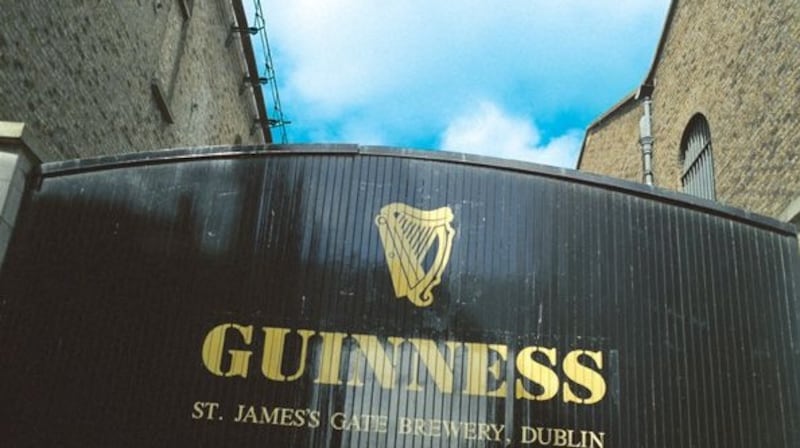Many of us Dubliners will have memories of “the good auld days” and the Guinness brewery stretching back years. Perhaps they are vignettes from a family friend or a forebear whose recollections we value? Great stories, from people we value, often.
In my own case, along with great banter, there was a reluctant drive from Castleknock with my dad into his office, either midweek or on a Saturday morning. I would wait for my dad to make a telephone call, read some document or other, or deliberate over some papers. The kindness of the support team in the chairman’s office and surrounding precincts at times broke up my youthly tedium, yet didn’t kill endless periods of “hanging on”.
It’s curious that I didn’t know more of the site back in those days: the tunnels, the giant brewhouse, the bottling, canning and keg plants, the hustle of the distribution yard. I can only think that other factors were at work alongside concern over the accompaniment of minors at an industrial complex.
Jump forward to the present day, and if you’re like me, the initial stomach churning reaction upon learning the news of the prospective redevelopment of the St James’s Gate brewery site may have been replaced by cries of guarded “Hallelujah!”
Physical presence
The underuse of the site is very obvious. From the weeds growing high up on walls, to the paint peeling off railings and windowsills. The giant physical presence of arguably the city’s foremost private sector employer is much too shrouded by cobwebs.
What of the opportunities? In a context where young and elderly alike find it an ever greater challenge to find a decent affordable place to live, this redevelopment of the brewery site can become a beacon of hope. The site offers housing opportunities for all, and I for one encourage this part of Dublin to “go up high”; the Guinness brewing legacy has much monumentalism, and surely it’s a better solution to utilise these structures, than for ever-wider areas of green countryside to be consumed by urban sprawl, at ever-increasing distances from the centre of the city, or anywhere particular for that matter.
The giant physical presence of arguably the city's foremost private sector employer is much too shrouded by cobwebs
Dublin’s central west district has long suffered from being a place to pass through rather than linger in. The civic amenities are sparse. True, there’s the Guinness theatre on site – now a lecture hall – and the swimming pool and gym but there’s limited green space and the Phoenix Park is too far away for a stroll at lunch break. There is no obvious public space to serve as a focal point or meeting spot.
Wouldn’t it be great to give a real diaspora of people the opportunity to live, to socialise and to work and mix in the locality; a self-contained holistic destination unto itself?
No ghetto of one thing or another please! Let’s create happy residents in quality housing stock, celebrative of their locality, as a destination for work, as much as for recreation.
Come on planners, make this so; with improved public transport links and a green and eco-friendly identity.
Beautiful buildings
Why would I visit the brewery site at present, unless I was pushing on with business, or enjoying the visitor’s attractions like Guinness’s Storehouse (itself transformed by Diageo as a beacon of excellence).
The beautiful buildings need love but how do they become relevant in an age of lower carbon consumption. It’s a golden opportunity. Restoration is notoriously more expensive than new build. But let’s preserve these iconic buildings to the highest contemporary standards, and narrate the story of the past in diverse and imaginative ways.
Let’s make the local air pollution-free, and create the smiles on people’s faces as they sit out on their balconies, or at their modern breezy offices; let’s rebirth the workforce, pushing on with their innovations to match the world-class brewing and almost certainly (now that’s more affirmative than “Probably” . . .) the most successful industrial heritage centre worldwide.

Isn’t it great there remains brewing on site and there’ll shortly be entire blocks reborn – hopefully with the confidence of the newly born, with an abiding nod of respect at the past.
I can’t wait for the rebirth and its new relevance to local institutions such as the new national children’s hospital, the Digital Hub, the Enterprise Centre, and whatever else. The fact that this is the partial redevelopment of an industrial site allows a series of successes to be accomplished, in a very meaningful scale to this capital city of ours.
Please do not build an identikit model community of yesteryear; let’s be brave, and innovative, and make the place into something we can once again cherish for its innovation and one that reflects the qualities of yesteryear, and one that is worthy of the special place that it earned as part of our collective identity.
DIAGEO’S PLANS FOR ST JAMES’S GATE
Last October, Diageo confirmed plans to develop 12.6 acres of its St James’s Gate site in the heart of Dublin in a major new rejuvenation project for the Liberties.
The Guinness brewer is in the process of looking for a development partner for the €1 billion project which aims to create a “dynamic” mixed-use urban district consisting of residential, office and commercial spaces. Six groups are under consideration for the project, with this soon to be reduced to a shortlist of three. A decision from Diageo is expected by the end of this year.
The new quarter will be opened up with public spaces and streets and is to be fully integrated into the wider local community, the company said.
“Our vision is that St James’s Gate Quarter can act as a catalyst for the continued regeneration of the Liberties, one of Dublin’s most exciting areas,” said Diageo Ireland country director Oliver Loomes.
“Our aim is to repurpose some of the wonderful old vat houses, cooperages and brewhouses, where Guinness was originally built, and to transform them into incredible spaces for a new generation of entrepreneurs, residents, visitors, dreamers and doers,” he added.
Arthur Edward Guinness, the fourth Lord Iveagh, is a trustee of the Iveagh Trust and a direct descendent of Arthur Guinness











